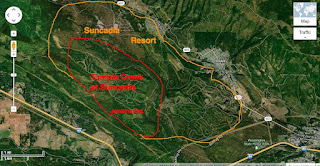One item that caught my eye is a white paper from Headwaters Economics (HE), called Solutions to the Rising Costs of Fighting Fires in the Wildland-Urban Interface. HE is based in Bozeman, MT, an area with even more WUI issues than we have in Kittitas County, if that's possible.
 Actually, I don't know if that statement, the one about Bozeman's WUI issues compared to ours, is really true, because Kittitas County's wildland development policies are so remarkably pro-development1 compared to other areas, and Bozeman has always seemed like a sensible place to me.
Actually, I don't know if that statement, the one about Bozeman's WUI issues compared to ours, is really true, because Kittitas County's wildland development policies are so remarkably pro-development1 compared to other areas, and Bozeman has always seemed like a sensible place to me.One key factor in determining WUI impacts is lot size, which determines the density of development outside of urban growth boundaries. The picture shows one example, selected mostly at random from Kittitas County's Assessor's interactive map site. This development's access road is a loop, suggesting that it at least provides firefighters and residents good access for firefighting or escape, but this post is about lot size.
The lots shown in the photo average about 3 acres in area. This is well below the 5 acre minimum allowed by Washington's Growth Management Act, which Kittitas County has been bound by since the early 1990s. Although the county agreed to the GMA, it has rarely, if ever, actually been in compliance, and we have lost repeated appeals and cases as high as the state Supreme Court.
Why would the county allow developments that are so obviously
a) illegal in light of the state GMA,The reasons can be complex, but they boil down to one thing: too much influence on County Commissioners by the development industry.2 We see this in the form of campaign donations and over-representation of developers on citizen's advisory committees. The makeup of citizens advisory committees is decided by the Commissioners, and there are plenty of examples where the Commissioners have denied seats to concerned citizens, or have allowed citizens with serious pro-development conflicts of interest to participate in policy making.3
b) dangerous to firefighters and residents in the event of a fire,
c) very expensive to defend from fire (these are tax dollars we're talking about), and
d) very expensive when it comes to provision of other services?
All three of the sitting commissioners, including Paul Jewell who is up for reelection this year, have been involved in decisions that have led to the unusual levels of property at risk to wildfire in Kittitas County.
1We're not anti-development! The development industry is very important! But, as we have unfortunately seen with the Taylor Bridge Fire, poorly regulated development at the UWI can be expensive and heartbreaking. Thank goodness there have been no serious injuries, but that's what's at stake, in a very real way, when considering development policies.
2There is an opportunity cost to paying too much attention to keeping developers happy. In addition to increasing fire danger, it takes away from time and other resources that could be used to encourage more sustainable growth in the county's job- and tax base.
3What the development industry wants, of course, is to keep costs as low as possible. That means maximizing the number of lots that can be platted on a given acreage, minimizing infrastructure costs borne by the developer, and maximizing infrastructure costs borne by taxpayers. Kittitas County has shown considerable willingness to help in all three areas, effectively socializing costs that should instead be paid by the developers.


